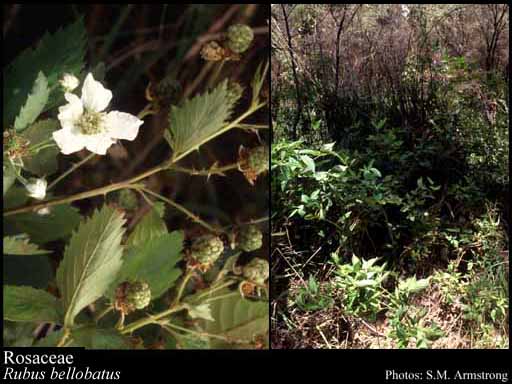- Reference
- Gen.Pl. [Jussieu] 334 (1789)
- Name Status
- Current

Scientific Description
Common name. Rose Family.
Habit and leaf form. Trees, or shrubs, or herbs; deciduous (usually), or evergreen. The herbs usually perennial; plants with a basal concentration of leaves, or with neither basal nor terminal concentrations of leaves. Self supporting, or climbing (sometimes); the climbers scrambling. Trees and shrubs leptocaul (often with ‘short shoots’). Helophytic, or mesophytic, or xerophytic. Leaves alternate (except Rhodotypos); spiral; ‘herbaceous’, or leathery; nearly always petiolate; sheathing, or non-sheathing. Leaf sheaths when leaves sheathing, with free margins. Leaves simple, or compound; epulvinate; when compound ternate, or pinnate, or palmate. Leaf blades when simple dissected, or entire; pinnately veined (usually), or palmately veined (e.g. Alchemilla); cross-venulate. Leaves with stipules (usually), or without stipules (in Spiraea etc.). Stipules intrapetiolar (often adnate to the petiole); free of one another; scaly, or leafy. Leaf blade margins crenate, or serrate, or dentate, or entire (rather infrequently). Vegetative buds scaly. Leaves without a persistent basal meristem. Domatia recorded (from 6 woody genera); represented by pits, or pockets, or hair tufts. Leaf anatomy. Hydathodes present (occasionally), or absent. Stem anatomy. Nodes tri-lacunar (usually), or unilacunar, or penta-lacunar to multilacunar. Secondary thickening developing from a conventional cambial ring.
Reproductive type, pollination. Fertile flowers hermaphrodite. Unisexual flowers absent. Plants hermaphrodite (usually). Anemophilous (occasionally, e.g. Poterium), or entomophilous (usually); commonly pollinated by flies. Pollination mechanism conspicuously specialized (occasionally), or unspecialized.
Inflorescence and flower features. Flowers solitary, or aggregated in ‘inflorescences’; in cymes, in panicles, in racemes, in corymbs, in umbels, and in fascicles. The terminal inflorescence unit when flowers aggregated cymose (usually), or racemose. Inflorescences terminal, or axillary; pseudanthial (occasionally), or not pseudanthial. Flowers small to large; often fragrant; usually regular; cyclic, or partially acyclic. Sometimes the gynoecium acyclic. Flowers tetracyclic to polycyclic. Floral receptacle developing a gynophore (rarely), or with neither androphore nor gynophore; markedly hollowed (Pomoideae, most Prunoideae, some Rosoideae (e.g. Rosa)), or not markedly hollowed (flattish or only slightly concave in Spiraeoideae, convex or swollen in some Rosoideae (e.g. Fragaria, Rubus)). Free hypanthium present (nearly always, the flower generally more or less perigynous), or absent. Hypogynous disk present (often), or absent; intrastaminal. Perianth with distinct calyx and corolla (usually), or sepaline; (5–)10(–20); 2 -whorled (usually), or 1 -whorled (when apetalous); usually isomerous. Calyx (3–)5(–10) (usually green and sepaloid); 1 -whorled; polysepalous, or gamosepalous; usually imbricate; regular; when determinable, with the median member posterior. Epicalyx present (often, its members alternating with the calyx and seemingly representing its stipules), or absent. Corolla when present, (3–)5(–10); 1 -whorled; polypetalous; usually imbricate; regular; white, or yellow, or red, or pink (but not blue). Androecium (1–)10–100 (usually ‘many’). Androecial members branched (often, in the sense that they are often disposed in pairs), or unbranched. Androecial sequence determinable, or not determinable. Androecial members when determinable, ‘at least sometimes’ maturing centripetally (Cronquist 1981); free of the perianth (but usually attached to a hypanthium); free of one another, or coherent; often more or less 5 - adelphous, or 10 - adelphous, or 15 - adelphous (etc. — in 5-adelphous whorls); 1–5 -whorled. Androecium exclusively of fertile stamens (normally), or including staminodes (in cultivars). Staminodes when present, 5–50 (several to ‘many’); when present, usually petaloid. Stamens (1–)20–100 (usually ‘many’); reduced in number relative to the adjacent perianth to isomerous with the perianth (rarely), or diplostemonous to polystemonous (usually); often with an outer whorl of 10 in five antesepalous pairs; inflexed in bud. Anthers dorsifixed; versatile (mostly), or non-versatile (rarely, e.g. Filipendula); dehiscing via longitudinal slits, or dehiscing via pores (terminal, occasionally); introrse (mostly), or latrorse (e.g. Potentilla); unilocular (sometimes, e.g. Alchemilla), or bilocular; tetrasporangiate. Gynoecium 1–50 carpelled. The pistil when monomeric or syncarpous, 1 celled, or 2–5 celled. Carpels isomerous with the perianth, or reduced in number relative to the perianth, or increased in number relative to the perianth. Gynoecium monomerous, or apocarpous, or syncarpous (Maloideae); of one carpel, or eu-apocarpous, or semicarpous, or synovarious (Maloideae); superior, or partly inferior, or inferior (occasionally even combining an inferior ovary with free carpels). Carpel when monomeric or apocarpous non-stylate, or stylate; apically stigmatic, or with a lateral style, or with a gynobasic style; when apocarpous 1–2 ovuled (usually), or 3–10 ovuled (Spiraeoideae). Placentation when apocarpous or one-carpelled marginal, or apical. Ovary when syncarpous, plurilocular; when syncarpous, 2–5 locular (Maloideae). Styles free. Stigmas wet type, or dry type; papillate, or non-papillate; Group II type, Group III type, and Group IV type. Placentation when syncarpous, axile. Ovules 1(–2) per locule; pendulous, or ascending; non-arillate; anatropous (nearly always), or hemianatropous, or campylotropous.
Fruit and seed features. Fruit fleshy, or non-fleshy; an aggregate (when carpels free), or not an aggregate. The fruiting carpels (when carpels free) commonly coalescing into a secondary syncarp (with small achenes or drupelets), or not coalescing. The fruiting carpel when apocarpous dehiscent, or indehiscent; a follicle, or an achene, or drupaceous, or baccate. Fruit when syncarpous dehiscent (rarely), or indehiscent; a capsule (Lindleya), or a berry (sometimes in the guise of a pome), or a drupe. The drupes with separable pyrenes, or with one stone. Fruit enclosed in the fleshy receptacle (or attached to it), or enclosed in the fleshy hypanthium, or without fleshy investment. Seeds non-endospermic (nearly always), or endospermic (copiously so in Physocarpus). Cotyledons 2 (usually expanded and flat). Embryo achlorophyllous (31/64), or chlorophyllous (Rhaphiolepis umbellata); straight, or curved, or bent. Seedling. Germination phanerocotylar, or cryptocotylar.
Physiology, biochemistry. Photosynthetic pathway: C3.
Geography, cytology, number of species. World distribution: cosmopolitan. X = 7–9, 17 (or more). 2000 species.
Economic uses, etc. Edible fruits from Malus spp. (apples), Prunus spp. (apricot, cherry, nectarine, peach, plums, prune, sloe), Cydonia (quince), Pyrus (pear), Eriobotrya (loquat), Rubus (blackberry, boysenberry, loganberry, rasberry), Fragaria (strawberry), Mespilus (medlar); nuts (Prunus — almond); many ornamental trees and shrubs or hedge-plants, e.g. Spiraea, Photinia, Kerria, Cotoneaster, Pyracantha, Crataegus, Sorbus, Rhodotypos, Prunus, Rosa, Potentilla; and some widely naturalized pests (e.g. from Acaena, Crataegus, Cotoneaster, Pyracantha).